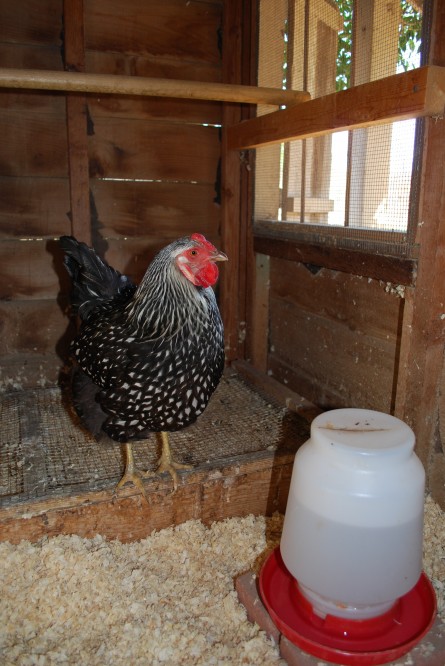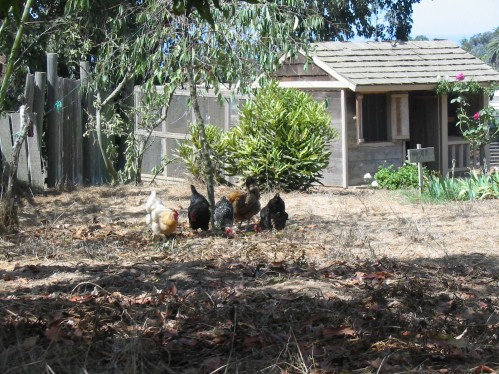 Two more important components of your chicken coop are the "Roosting Bar" and "Manure Box". Housed chickens do not sleep in nesting boxes, or on the floor of their chicken coop, they sleep shoulder to shoulder on an elevated roosting bar at night. This bar actually assimilates a tree limb. Chickens that roam free, such as in Key West, Florida, instinctively know they can better protect themselves from predators up in a tree on a limb at night. The same concept holds true for your backyard flock utilizing their night roosting bar inside their chicken coop.
Two more important components of your chicken coop are the "Roosting Bar" and "Manure Box". Housed chickens do not sleep in nesting boxes, or on the floor of their chicken coop, they sleep shoulder to shoulder on an elevated roosting bar at night. This bar actually assimilates a tree limb. Chickens that roam free, such as in Key West, Florida, instinctively know they can better protect themselves from predators up in a tree on a limb at night. The same concept holds true for your backyard flock utilizing their night roosting bar inside their chicken coop.
The roosting bar is a simple solid dowel, about 1.5" in diameter, that is secured in place, usually opposite the side of the nesting boxes. Allow 6"-10" width of roosting bar space per hen. Our roosting bar is positioned 2'8" high from the chicken coop floor. Depending on your chicken coop design, you might want to vary the height up or down a bit. You want it to be comfortable for your hens to perch on. Underneath the roosting bar is the manure box.
The manure box is a beautiful thing. It is situated directly below the roosting bar, filled with bedding, and a moveable screen lid. This screen lid should be made of durable half-inch wire mesh.
Most of your chicken manure droppings will fall to the manure screen lid and box during the night. It is almost like a "cat litter box", but an equivalent concept for chickens. I skim the screen and bedding with manure from the box, and take it to my nearby compost pile, along with my kitchen vegetable scraps. The chicken coop is clean for the day. You can let the manure pile up, but I find it best overall to get it out of the coop and into the compost pile. Every month or so, I take the manure box top screen outside, and really hose it off, brush it down with soap and water and then let it dry throughly before returning it to the chicken coop.
I have seen chicken coop designs that allow you to access the manure box from the outside, with a closable shutter. My preference with manure boxes is to make sure they can be moved and are not stationary. You want to have access to this area, to throughly deep clean it from time to time.
I find that our chickens don't leave many manure droppings in their nesting boxes, or even the floor of their chicken coop. Manure droppings are mainly deposited in the manure box at night, and the outside pen during the day. I rotate my bedding to keep the chicken coop clean. Fresh clean bedding goes to the nesting boxes first, then the chicken coop floor second, and last to the manure box, before I take it out to the compost. By using this method, my bedding is optimized, and I only need to clean the entire chicken coop once a quarter or so.
One last word on the roosting bar. You might have noticed that many of my photos of our "Hollywood Girls" are taken in our gardens or outside of their chicken coop, after I have been preaching about protecting and containing your chickens. First of all, you have to know your chicken flock, and what they will do. Our chickens love to explore our property, and are quite well-behaved. I only let our chickens out, when I am home, and in the garden to keep one eye on them. I never let them out and then run to the grocery store. I always leave the front door of their chicken coop open, so they can come back for water or a little laying mash. With that said, if you let your chickens out in your yard or property, at dusk they will come back to their chicken coop faithfully, and head straight to their roosting bar for the night. Once they are in, make sure to secure them in, by locking their door and windows for the night.

 Hen nesting boxes are a way of organizing your hens and their business of egg-laying. If you do not provide nesting boxes, you could find eggs everywhere as if you were at an "Easter Egg Hunt". You wouldn't know where they were laid, or how fresh they were.
Hen nesting boxes are a way of organizing your hens and their business of egg-laying. If you do not provide nesting boxes, you could find eggs everywhere as if you were at an "Easter Egg Hunt". You wouldn't know where they were laid, or how fresh they were.

 When we bought our property in the late '90's, it was sadly run down, but with a few treasures such as an old child's playhouse close to our garage. Once we were acclimated, we turned our attention to the potential of gardens, shaped trees, and desirable landscape. Soon after that we dragged the extremely heavy child's playhouse, long abandoned, down to a quiet southwest corner of our property. We saw the potential for modifying this "cutie pie" house into a perfect country coop for our soon-to-be-arriving hens.
When we bought our property in the late '90's, it was sadly run down, but with a few treasures such as an old child's playhouse close to our garage. Once we were acclimated, we turned our attention to the potential of gardens, shaped trees, and desirable landscape. Soon after that we dragged the extremely heavy child's playhouse, long abandoned, down to a quiet southwest corner of our property. We saw the potential for modifying this "cutie pie" house into a perfect country coop for our soon-to-be-arriving hens.
 Since I started writing about our chickens, there has been a lot of interest and questions on how to care for them. What are the components of a good chicken coop, and what kind of environment provided makes for healthy, happy, chickens. I think that many potential backyard enthusiasts would like to have chickens, but don't know what all is necessary to provide for them. I hope that I can clarify that for you.
Since I started writing about our chickens, there has been a lot of interest and questions on how to care for them. What are the components of a good chicken coop, and what kind of environment provided makes for healthy, happy, chickens. I think that many potential backyard enthusiasts would like to have chickens, but don't know what all is necessary to provide for them. I hope that I can clarify that for you. If you are a gardener, chances are you like to grow herbs, too. One of the most beautiful herbs I have ever grown is the ornamental oregano, Kent Beauty, Origanum rotundifolium. While most oregano varieties are grown for their culinary use, Kent Beauty and a few other ornamental oregano varieties are not, and in fact, have no taste at all. Ornamental oregano are best used for their beauty in gardens, borders, and especially containers.
If you are a gardener, chances are you like to grow herbs, too. One of the most beautiful herbs I have ever grown is the ornamental oregano, Kent Beauty, Origanum rotundifolium. While most oregano varieties are grown for their culinary use, Kent Beauty and a few other ornamental oregano varieties are not, and in fact, have no taste at all. Ornamental oregano are best used for their beauty in gardens, borders, and especially containers. Last year my husband, John, and I were featured in an article called "Grow Greener" highlighting our flower/vegetable gardens, and organic practices in, Nature's Garden magazine, Spring 2008,
Last year my husband, John, and I were featured in an article called "Grow Greener" highlighting our flower/vegetable gardens, and organic practices in, Nature's Garden magazine, Spring 2008, 